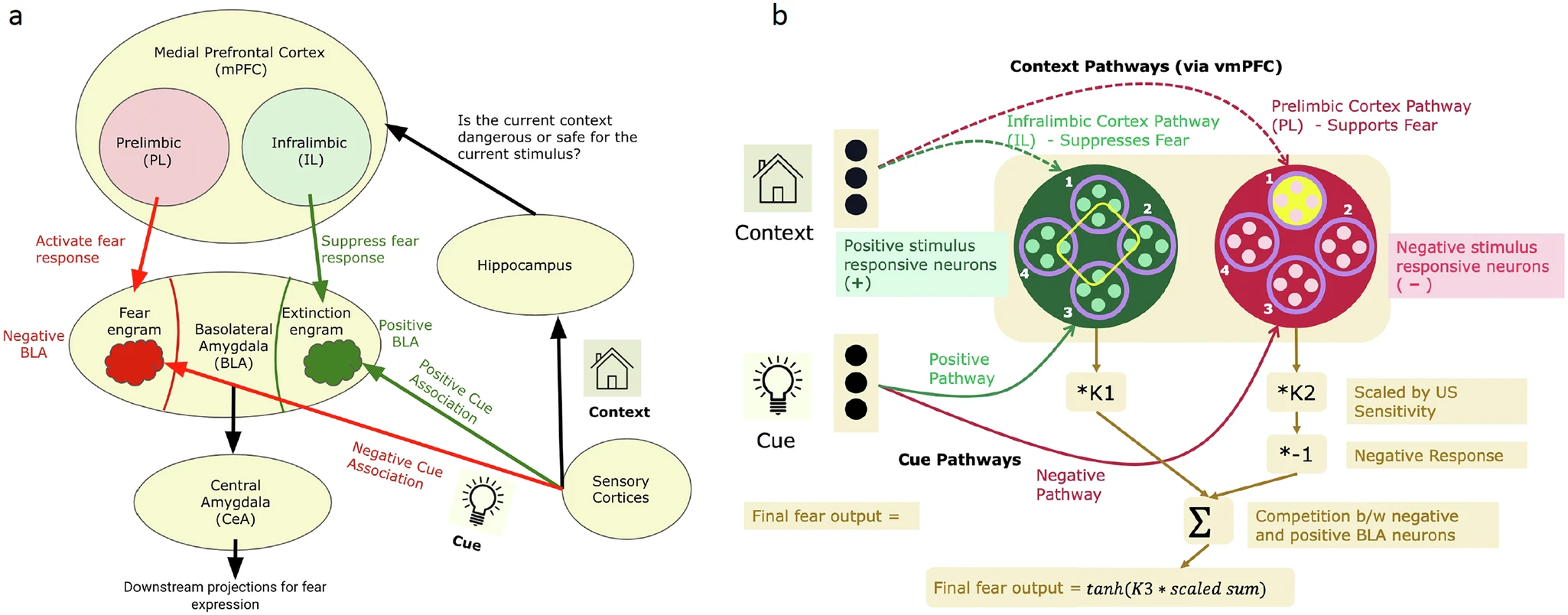A neurally constrained computational model of context-dependent fear extinction recall and relapse
Overview

The model processes two distinct inputs on each experimental trial: a cue input and a context input.
Cue Input: Represents sensory information about a CS, such as a light or tone. This input is analogous to sensory cortices and is depicted by a lightbulb icon in Fig. 1b.
Context Input: Represents features of the environmental context in which the cue is presented. This input is conceptually linked to the Neuroscience/hippocampal CA1 region, which encodes context information and is depicted by a house icon in Fig. 1b.
Both inputs project to the Neuroscience/basolateral amygdala (BLA), where emotional associations are encoded. The BLA consists of two distinct neuronal populations that respond to different types of stimuli:
Positive BLA Population:
This population contains neurons that respond to positive stimuli and encode safety or reward-related associations. In Fig. 1b, the positive BLA population is indicated by the green circle, with existing US representations, depicted as small purple circles, corresponding to rewarding stimuli such as juice or food pellets. The model assumes that extinction engrams are formed within this population, utilizing the reward circuitry to suppress fear responses and highlighting the overlap between extinction learning and reward processing.
Negative BLA Population:
This population consists of neurons that respond to negative or threat-related stimuli and encode fear associations. In Fig. 1b, the negative BLA population is indicated by the red circle. Existing US representations within this population, also depicted as small purple circles, correspond to aversive stimuli such as foot shocks or puffs of air. The model posits that fear acquisition strengthens the associations between threat-related cues, contexts, and the US representations within the negative BLA population.
The cue input connects directly to both BLA populations via distinct positive and negative cue pathways from the sensory cortices. The context input reaches the BLA via distinct positive and negative context pathways from the hippocampal CA1 region, through the infralimbic (IL) and prelimbic (PL) regions of the ventromedial prefrontal cortex (VmPFC) respectively. The context pathways include:
-
Infralimbic (IL) Pathway (Positive Context Pathway): Connects the Hippocampus CA1 region to the positive BLA population via the IL, facilitating fear suppression.
-
Prelimbic (PL) Pathway (Negative Context Pathway): Connects the Hippocampus CA1 region to the negative BLA population via the PL, promoting fear expression.
Poster
https://github.com/shreyakr96/CompModelFear/blob/main/CNS_poster_2024_final.pdf
Conclusion
We present a neurally constrained computational model that offers a novel framework for understanding the mechanisms underlying fear acquisition, extinction, and the context-dependent return of fear. By incorporating distinct cue and context pathways and simulating the formation of separate fear and extinction engrams in the BLA, ConFER captures key experimental findings and generates testable hypotheses—particularly regarding the efficacy of counterconditioning over traditional extinction methods. These insights enhance our understanding of the neural underpinnings of fear learning and relapse, with significant potential for informing and improving clinical interventions for anxiety disorders.